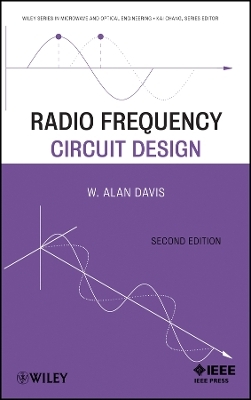
Radio Frequency Circuit Design 2e
Wiley-Blackwell (Hersteller)
978-0-470-76802-0 (ISBN)
- Keine Verlagsinformationen verfügbar
- Artikel merken
W. ALAN DAVIS is a professor in the department of electrical engineering at the University of Texas at Arlington. He was previously employed at Raytheon, where he worked on IMPATT diode power combiners, thermal response of IMPATT diodes, broadband directional couplers, Schiffman phase shifters, and filter design. He was also involved in computer optimization techniques and in software design for automated test stations. More recently, Davis has worked on nonlinear parametric effects and self-heating effects of silicon on insulator transistors.
Preface to the Second Edition. Preface to the First Edition. 1 Information Transfer Technology. 1.1 Introduction. 1.2 Information and Capacity. 1.3 Dependent States. 1.4 Basic Transmitter?Receiver Confi guration. 1.5 Active Device Technology. Problems. Reference. 2 Resistors, Capacitors, and Inductors. 2.1 Introduction. 2.2 Resistors. 2.3 Capacitors. 2.4 Inductors. 2.5 Conclusions. Problems. References. 3 Impedance Matching. 3.1 Introduction. 3.2 The Q Factor. 3.3 Resonance and Bandwidth. 3.4 Unloaded Q . 3.5 L Circuit Impedance Matching. 3.6 PI Transformation Circuit. 3.7 T Transformation Circuit. 3.8 Tapped Capacitor Transformer. 3.9 Parallel Double-Tuned Transformer. 3.10 Conclusions. Problems. References. 4 Multiport Circuit Parameters and Transmission Lines. 4.1 Voltage?Current Two-Port Parameters. 4.2 ABCD Parameters. 4.3 Image Impedance. 4.4 Telegrapher's Equations. 4.5 Transmission Line Equation. 4.6 Smith Chart. 4.7 Transmission Line Stub Transformer. 4.8 Commonly Used Transmission Lines. 4.9 Scattering Parameters. 4.10 Indefinite Admittance Matrix. 4.11 Indefinite Scattering Matrix. 4.12 Conclusions. Problems. References. 5 Filter Design and Approximation. 5.1 Introduction. 5.2 Ideal and Approximate Filter Types. 5.3 Transfer Function and Basic Filter Concepts. 5.4 Ladder Network Filters. 5.5 Elliptic Filter. 5.6 Matching Between Unequal Resistance Levels. 5.7 Conclusions. Problems. References. 6 Transmission Line Transformers. 6.1 Introduction. 6.2 Ideal Transmission Line Transformers. 6.3 Transmission Line Transformer Synthesis. 6.4 Electrically Long Transmission Line Transformers. 6.5 Baluns. 6.6 Dividers and Combiners. 6.7 The 90? Coupler. Problems. References. 7 Noise in RF Amplifiers. 7.1 Sources of Noise. 7.2 Thermal Noise. 7.3 Shot Noise. 7.4 Noise Circuit Analysis. 7.5 Amplifier Noise Characterization. 7.6 Noise Measurement. 7.7 Noisy Two-Port Circuits. 7.8 Two-Port Noise Factor Derivation. 7.9 Fukui Noise Model for Transistors. Problems. References. 8 Class A Amplifiers. 8.1 Introduction. 8.2 Defi nitions of Gain. 8.3 Transducer Power Gain of a Two-Port Network. 8.4 Power Gain Using S Parameters. 8.5 Simultaneous Match for Maximum Power Gain. 8.6 Stability. 8.7 Class A Power Amplifiers. 8.8 Power Combining of Power Amplifiers. 8.9 Properties of Cascaded Amplifiers. 8.10 Amplifier Design for Optimum Gain and Noise. 8.11 Conclusions. Problems. References. 9 RF Power Amplifiers. 9.1 Transistor Configurations. 9.2 Class B Amplifier. 9.3 Class C Amplifier. 9.4 Class C Input Bias Voltage. 9.5 Class D Power Amplifier. 9.6 Class E Power Amplifier. 9.7 Class F Power Amplifier. 9.8 Feed-Forward Amplifiers. 9.9 Conclusions. Problems. References. 10 Oscillators and Harmonic Generators. 10.1 Oscillator Fundamentals. 10.2 Feedback Theory. 10.3 Two-Port Oscillators with External Feedback. 10.4 Practical Oscillator Example. 10.5 Minimum Requirements of the Reflection Coefficient. 10.6 Common Gate (Base) Oscillators. 10.7 Stability of an Oscillator. 10.8 Injection-Locked Oscillator. 10.9 Oscillator Phase Noise. 10.10 Harmonic Generators. Problems. References. 11 RF Mixers. 11.1 Nonlinear Device Characteristics. 11.2 Figures of Merit for Mixers. 11.3 Single-Ended Mixers. 11.4 Single-Balanced Mixers. 11.5 Double-Balanced Mixers. 11.6 Double-Balanced Transistor Mixers. 11.7 Spurious Response. 11.8 Single-Sideband Noise Factor and Noise Temperature. 11.9 Special Mixer Applications. 11.10 Conclusions. Problems. References. 12 Phase-Lock Loops. 12.1 Introduction. 12.2 PLL Design Background. 12.3 PLL Applications. 12.4 PLL Basics. 12.5 Loop Design Principles. 12.6 Linear Analysis of the PLL. 12.7 Locking a Phase-Lock Loop. 12.8 Loop Types. 12.9 Negative Feedback in a PLL. 12.10 PLL Design Equations. 12.11 Phase Detector Types. 12.12 Design Examples. 12.13 Conclusions. Problems. References. Appendix A Example of a Solenoid Design. Appendix B Analytical Spiral Inductor Model. Appendix C Double-Tuned Matching Circuit Example. Appendix D Two-Port Parameter Conversion. Appendix E Termination of a Transistor Port with a Load. Appendix F Transistor and Amplifier Formulas. Appendix G Transformed Frequency-Domain Measurements Using SPICE. Appendix H Single-Tone Intermodulation Distortion Suppression for Double-Balanced Mixers. Index.
| Erscheint lt. Verlag | 5.10.2010 |
|---|---|
| Verlagsort | Hoboken |
| Sprache | englisch |
| Themenwelt | Technik ► Elektrotechnik / Energietechnik |
| Technik ► Nachrichtentechnik | |
| ISBN-10 | 0-470-76802-9 / 0470768029 |
| ISBN-13 | 978-0-470-76802-0 / 9780470768020 |
| Zustand | Neuware |
| Informationen gemäß Produktsicherheitsverordnung (GPSR) | |
| Haben Sie eine Frage zum Produkt? |
aus dem Bereich
